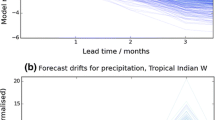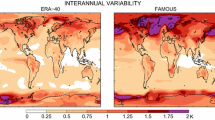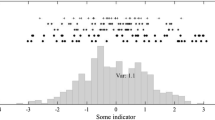Abstract
Ensembles of coupled atmosphere–ocean global circulation model simulations are required to make probabilistic predictions of future climate change. “Perturbed physics” ensembles provide a new approach in which modelling uncertainties are sampled systematically by perturbing uncertain parameters. The aim is to provide a basis for probabilistic predictions in which the impact of prior assumptions and observational constraints can be clearly distinguished. Here we report on the first perturbed physics coupled atmosphere–ocean model ensemble in which poorly constrained atmosphere, land and sea-ice component parameters are varied in the third version of the Hadley Centre model (the variation of ocean parameters will be the subject of future study). Flux adjustments are employed, both to reduce regional sea surface temperature (SST) and salinity biases and also to admit the use of combinations of model parameter values which give non-zero values for the global radiation balance. This improves the extent to which the ensemble provides a credible basis for the quantification of uncertainties in climate change, especially at a regional level. However, this particular implementation of flux-adjustments leads to a weakening of the Atlantic overturning circulation, resulting in the development of biases in SST and sea ice in the North Atlantic and Arctic Oceans. Nevertheless, model versions are produced which are of similar quality to the unperturbed and un-flux-adjusted version. The ensemble is used to simulate pre-industrial conditions and a simple scenario of a 1% per year compounded increase in CO2. The range of transient climate response (the 20 year averaged global warming at the time of CO2 doubling) is 1.5–2.6°C, similar to that found in multi-model studies. Measures of global and large scale climate change from the coupled models show simple relationships with associated measures computed from atmosphere-mixed-layer-ocean climate change experiments, suggesting that recent advances in computing the probability density function of climate change under equilibrium conditions using the perturbed physics approach may be extended to the transient case.











Similar content being viewed by others
Notes
Errors in observations of the climate system are a further source of uncertainty, but here we focus on the issue from the climate modelling perspective.
References
Andronova NG, Schlesinger ME (2001) Objective estimation of the probability density function for climate sensitivity. J Geophys Res 106:22605–22611
Barnett DN, Brown SJ, Murphy JM, Sexton DMH, Webb MJ (2006) Quantifying uncertainty in changes in extreme event frequency in response to doubled CO2 using a large ensemble of GCM simulations. Clim Dyn (in press). DOI 10.1007/s00382-005-0097-1
Collins M (2000) Understanding Uncertainties in the response of ENSO to Greenhouse Warming. Geophys Res Lett 27:3509–3513
Collins M, Tett SFB, Cooper C (2001) The internal climate variability of HadCM3, a version of the Hadley Centre coupled model without flux adjustments. Clim Dyn 17:61–81
Collins M., the CMIP2 Modelling Groups (2005) El Niño- or La Niña-like climate change? Clim Dyn 24:89–104
Covey C, AchutaRao KM, Cubasch U, Jones P, Lambert SJ, Mann ME, Phillips TJ, Taylor KE (2003) An overview of results from the Coupled Model Intercomparison Project. Glob Planet Change 37:103–133
Cox PM, Betts RA, Jones CD, Spall SA, Totterdell IJ (2000) Acceleration of global warming due to carbon-cycle feedbacks in a coupled climate model. Nature 408:184–187
Cox PM, Betts RA, Collins M, Harris PP, Huntingford C, Jones CD (2004) Amazonian forest dieback under climate-carbon cycle projections for the 21st century. Theoret Appl Climatol 78:137–156
Cubasch U, Meehl GA, Boer GJ, Stouffer RJ, Dix M, Noda A, Senior CA, Raper S, Yap KS (2001) Projections of future climate change. In: Climate Change 2001: The Scientific Basis. In: Houghton JT, Ding Y, Griggs DJ, Noguer M, van der Linden P, Dai X, Maskell K, Johnson CI (eds.) Contribution of Working Group I to the third assessment report of the intergovernmental panel on climate change. Cambridge University Press, 525–582
Doblas-Reyes FJ, Hagedorn R, Palmer TN (2005) The rationale behind the success of multi-model ensembles in seasonal forecasting. Part II: Calibration and combination. Tellus (in press)
Forest CE, Stone PH, Sokolov AP, Allen MR, Webster MD (2002) Quantifying uncertainties in climate system properties with the use of recent climate observations. Science 295:113–117
Ganachaud A, Wunsch C (2000) Improved estimates of global ocean circulation, heat transport and mixing from hydrographic data. Nature 408:453–457
Gordon C, Cooper C, Senior CA, Banks H, Gregory JM, Johns TC, Mitchell JFB, Wood RA (2000) The simulation of SST, sea ice extents and ocean heat transport in a version of the Hadley Centre coupled model without flux adjustments. Clim Dyn 16:147–168
Gregory JM, Ingram WJ, Palmer MA, Jones GS, Stott PA, Thorpe RB, Lowe JA, Johns TC, Williams KD (2004) A new method for diagnosing radiative forcing and climate sensitivity. Geophs Res Lett 31:L03205
Grist JP, Josey SA (2003) Inverse analysis adjustment of the SOC air-sea flux climatology using ocean heat transport constraints. J Clim 20:3274–3295
Hagedorn R, Doblas-Reyes FJ, Palmer TN (2004) The rationale behind the success of multimodel ensembles in seasonal forecasting. Part I: Basic concept. Tellus (in press)
Knutti R, Stocker TF, Joos F, Plattner GK (2002) Constraints on radiative forcing and future climate change from observations and climate model ensembles. Nature, 416:719–723
Lambert SJ, Boer GJ (2001) CMIP1 evaluation and intercomparison of coupled climate models. Clim Dyn 17:83–106
Levitus S, Boyer T (1994) World Ocean Atlas 1994. NOAA Atlas NESDIS, U.S. Department of Commerce, Washington
MacDonald AM, Wunsch C (1996) An estimate of global ocean circulation and heat fluxes. Nature 382:436–439
Manabe S, Stouffer RJ (1988) Two stable equilibria of a coupled ocean-atmosphere model. J Clim 1:841–866
Meehl GA, Washington WM, Arblaster JM, Hu A (2004) Factors affecting climate sensitivity in global coupled models. J Clim 17:1584–1596
Molteni F, Buzzia R, Palmer TN, Petroliagis T (1996) The ECMWF ensemble prediction system: methodology and validation. Quart J Roy Met Soc 122:73–119
Murphy JM (1995) Transient response of the Hadley Centre coupled ocean-atmosphere model to increasing carbon dioxide. Part III: Analysis of global mean response using simple models. J Clim 8:496–514
Murphy JM, Sexton DMH, Barnett DN, Jones GS, Webb MJ, Collins M, Stainforth DA (2004) Quantification of modelling uncertainties in a large ensemble of climate change simulations. Nature 430:768–772
Palmer TN (2001) A nonlinear dynamical perspective on model error: A proposal for non-local stochastic-dynamic parametrization in weather and climate prediction models. Quart J Roy Met Soc 127:279–304
Palmer TN (2002) The economic value of ensemble forecasts as a tool for risk assessment: From days to decades. Quart J Roy Met Soc 128:747–774
Piani C, Frame DJ, Stainforth DA, Allen MR (2005) Constraints on climate change from a multi-thousand member ensemble of simulations. Geophys Res Lett 32:L23825. DOI 10.1029/2005GL024452
Pope VD, Gallani ML, Rowntree PR, Stratton RA (2000) The impact pf new physical parametrizations in the Hadley Centre climate model—HadAM3. Clim Dyn 16:123–146
Raper SCB, Gregory JM, Osborn TJ (2001) Use of an upwelling-diffusion energy balance climate model to simulate and diagnose A/OGCM results. Clim Dyn 17:601–613
Raper SCB, Gregory JM, Stouffer RJ (2002) The role of climate sensitivity and ocean heat uptake on AOGCM transient temperature response. J Clim, 15:124–130
Rayner NA, Parker DE, Horton EB, Folland CK, Alexander LV, Rowell DP, Kent EC, Kaplan A (2003) Global analyses of SST, sea ice and night marine air temperature since the late nineteenth century. J Geophys Res 108:10.1029/2002JD002670
Robertson AW, Lall U, Zebiak SE, Goddard L (2004) Improved combination of multiple atmospheric GCM ensembles for seasonal prediction. Month Weather Rev 132:2732–2744
Senior CA, Mitchell JFB (2000) The time-dependence of climate sensitivity. Geophys Res Letts 27:2685–2688
Senior C, Wielicki B, McAvaney B, Boer G (2004) Report on the joint WCRP CFMIP/IPCC expert meeting on climate sensitivity and feedbacks. Annex 5 of IPCC Working Group 1 report of the Workshop on Climate Sensivity
Stainforth DA, Aina T, Christensen C, Collins M, Faull N, Frame DJ, Kettleborough JA, Knight S, Martin A, Murphy JM, Piani C, Sexton D, Smith LA, Spicer RA, Thorpe AJ, Allen MR (2005) Uncertainty in predictions of the climate response to rising levels of greenhouse gases. Nature 433:403–406
Tebaldi C, Smith RL, Nychka D, Mearns LO (2005) Quantifying uncertainty in projections of regional climate change: a Bayesian approach to the analysis of multi-model ensembles. J Clim 18:1524–1540
Thorpe RB, Gregory JM, Johns TC, Wood RA, Mitchell JFB (2001) Mechanisms determining the Atlantic thermohaline circulation response to greenhouse gas forcing in a non-flux-adjusted coupled climate model. J Clim 14:3102–3116
Toth Z, Kalnay E (1997) Ensemble forecasting at NCEP and the breeding method. Month Weather Rev 125:3297–3319
Vellinga M, Wu PL (2004) Low-latitude freshwater influence on centennial variability of the Atlantic thermohaline circulation. J Clim 17:4498–4511
Webb MJ, Senior CA, Williams KD, Sexton MDH, Ringer MA, McAvaney BJ, Colman R, Soden BJ, Andronova NG, Emori S, Tsushima Y, Ogura T, Musat I, Bony S, Taylor K (2006) On uncertainty in feedback mechanisms controlling climate sensitivity in two GCM ensembles. Clim Dyn (in press). DOI 10.1007/s00382-006-0111-2
Wigley TML, Raper SCB (2001). Interpretation of high projections for global-mean warming. Science, 293:451–454
Wood RA, Keen AB, Mitchell JFB, Gregory JM (1999) Changing spatial structure of the thermohaline circulation in response to atmospheric CO2 forcing in a climate model. Nature 399:572–575
Acknowledgements
This work could not have been possible without the input from numerous and dedicated Hadley Centre staff, in particular Peter Good who downloaded the AR4 model data and Ian Culverwell who supplied the ocean heat transport data. Chris Brierley also helped in the analysis of ocean heat uptake efficiency. The work was supported by the UK Department of the Environment, Food and Rural Affairs under Contract PECD/7/12/37 and by the European Community ENSEMBLES (GOCE-CT-2003–505539) and DYNAMITE (GOCE-003903) projects under the Sixth Framework Programme. We acknowledge the international modeling groups for providing their data for analysis, the Program for Climate Model Diagnosis and Intercomparison (PCMDI) for collecting and archiving the model data, the JSC/CLIVAR Working Group on Coupled Modelling (WGCM) and their Coupled Model Intercomparison Project (CMIP) and Climate Simulation Panel for organizing the model data analysis activity, and the IPCC WG1 TSU for technical support. The IPCC Data Archive at Lawrence Livermore National Laboratory is supported by the Office of Science, U.S. Department of Energy.
Author information
Authors and Affiliations
Corresponding author
Rights and permissions
About this article
Cite this article
Collins, M., Booth, B.B.B., Harris, G.R. et al. Towards quantifying uncertainty in transient climate change. Clim Dyn 27, 127–147 (2006). https://doi.org/10.1007/s00382-006-0121-0
Received:
Accepted:
Published:
Issue Date:
DOI: https://doi.org/10.1007/s00382-006-0121-0




